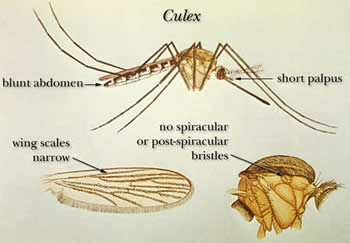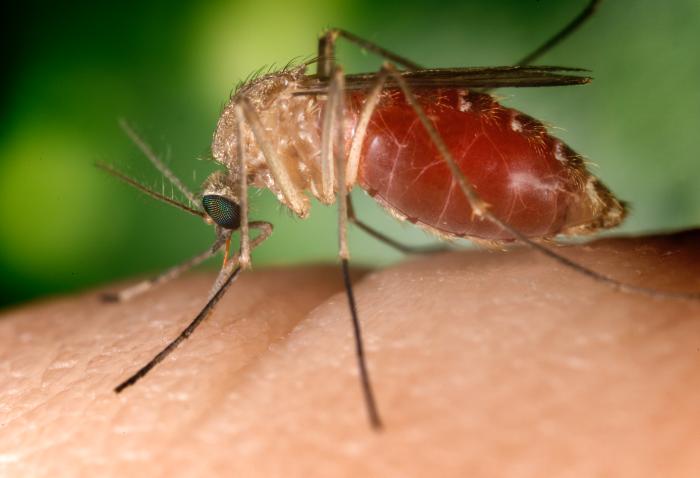Culex
Culex
Culex
Culex
Culex
Culex pipiens is the most widely distributed mosquito in the world. It is found on every continent except Antarctica and it carries a number of diseases, especially arboviruses (arthropod-borne virus). Culex tarsalis is a vector for Western Equine encephalitis.
Eggs of these mosquitoes, typically for culicines, are laid singly or in rafts and although they may stick to the surface, they may sink if the water is disturbed. Culex prefers water contaminated with organic matter for the development of the larvae and in will grow well in septic tanks.
Disease is spread by females. Males do not bite. The females take blood meals that are used to support the development of eggs. Culex is described as zoophagic because it takes its meals from animals as well as humans and can also be described as ornithophagic because it frequently feeds on birds. Any disease that is carried by Culex can therefore become difficult to eradicate because any animal community that it feeds on can become a reservoir and mobile species, such as birds, can spread the disease through a large area. This was seen in 1999 in the Eastern United States when West Nile virus was introduced into the area. Culex pipiens feeds at night.
Feeding is described as endophagic because the mosquito prefers to feed in and around structures and the mosquito then rests in cool damp spots within structures while the meal is digested (endophilic behavior). A blood meal takes 2-7 days to digest and 1-3 meals are needed to complete development of clutch of eggs. Transmission comes from repeated biting when the mosquito injects saliva that acts as an anticoagulant.
Eggs of these mosquitoes, typically for culicines, are laid singly or in rafts and although they may stick to the surface, they may sink if the water is disturbed. Culex prefers water contaminated with organic matter for the development of the larvae and in will grow well in septic tanks.
Disease is spread by females. Males do not bite. The females take blood meals that are used to support the development of eggs. Culex is described as zoophagic because it takes its meals from animals as well as humans and can also be described as ornithophagic because it frequently feeds on birds. Any disease that is carried by Culex can therefore become difficult to eradicate because any animal community that it feeds on can become a reservoir and mobile species, such as birds, can spread the disease through a large area. This was seen in 1999 in the Eastern United States when West Nile virus was introduced into the area. Culex pipiens feeds at night.
Feeding is described as endophagic because the mosquito prefers to feed in and around structures and the mosquito then rests in cool damp spots within structures while the meal is digested (endophilic behavior). A blood meal takes 2-7 days to digest and 1-3 meals are needed to complete development of clutch of eggs. Transmission comes from repeated biting when the mosquito injects saliva that acts as an anticoagulant.




No comments:
Post a Comment